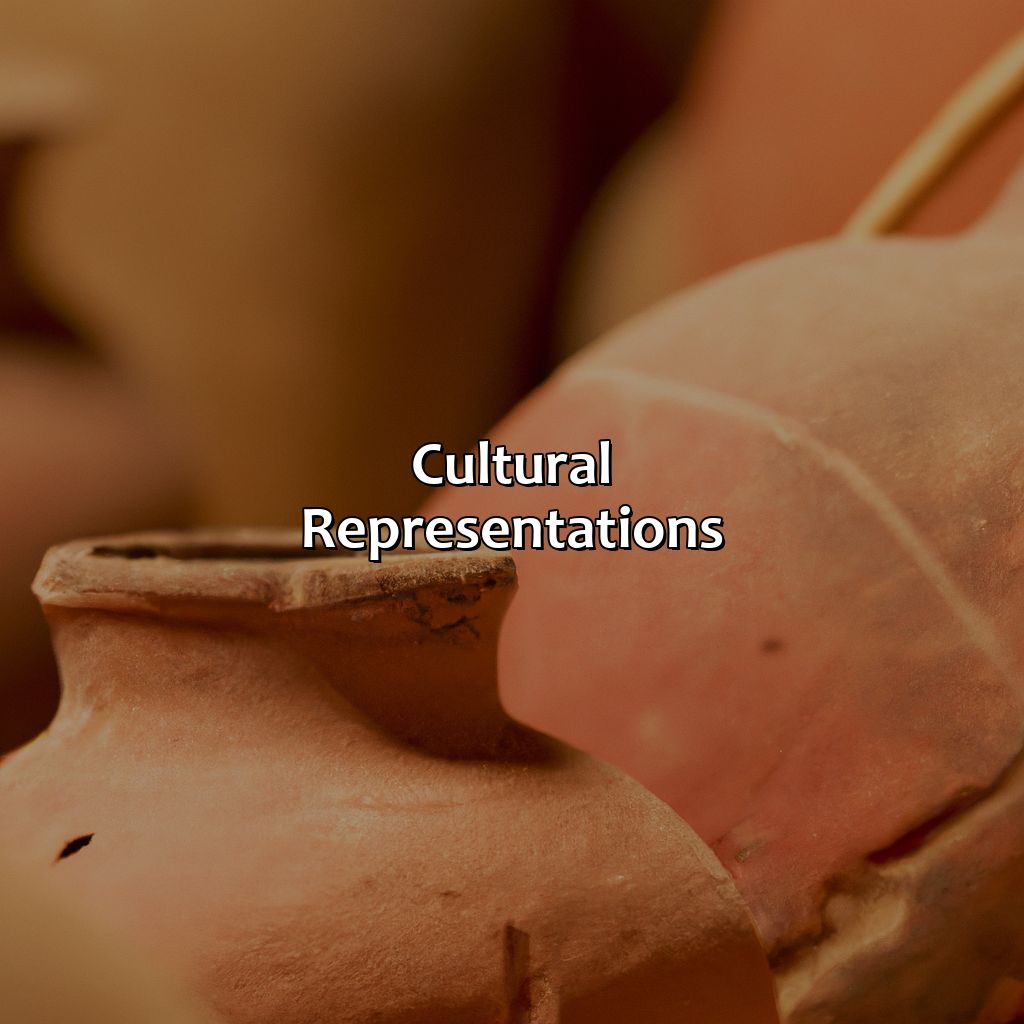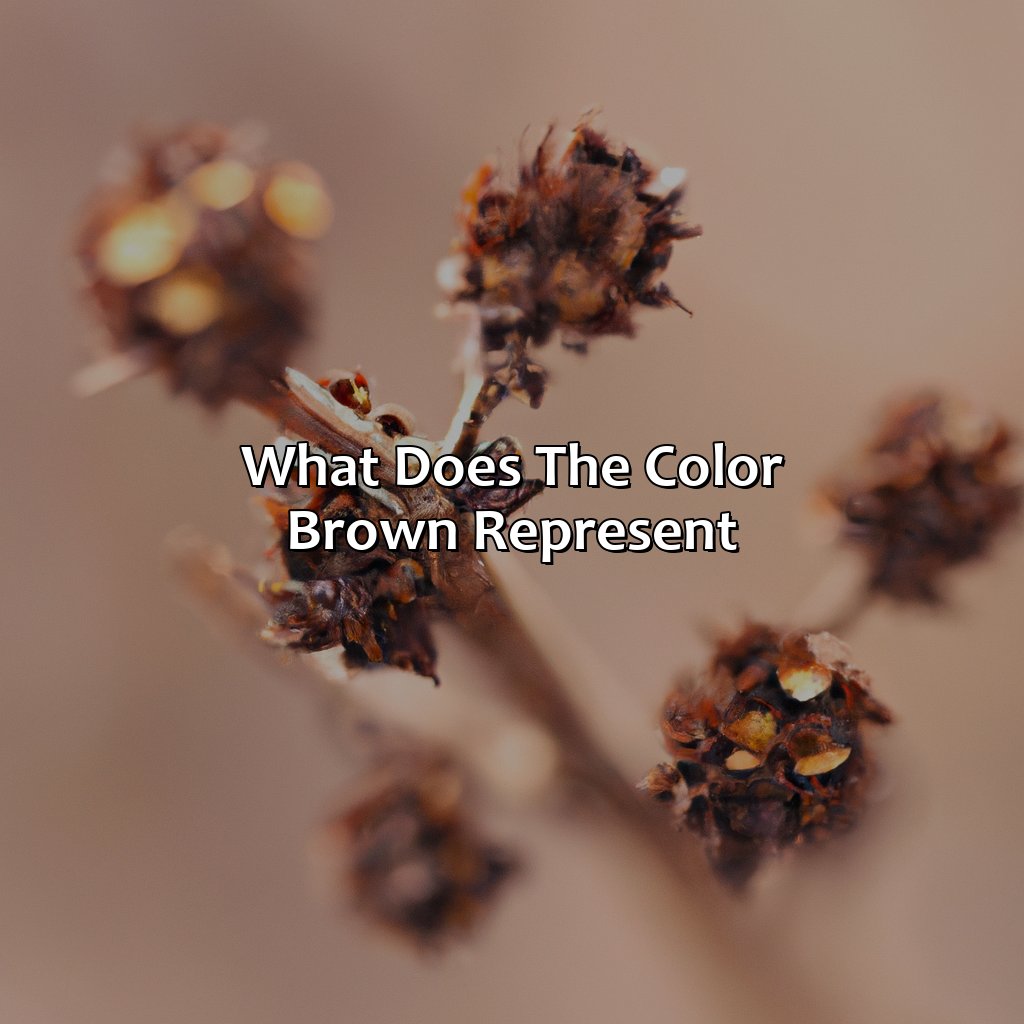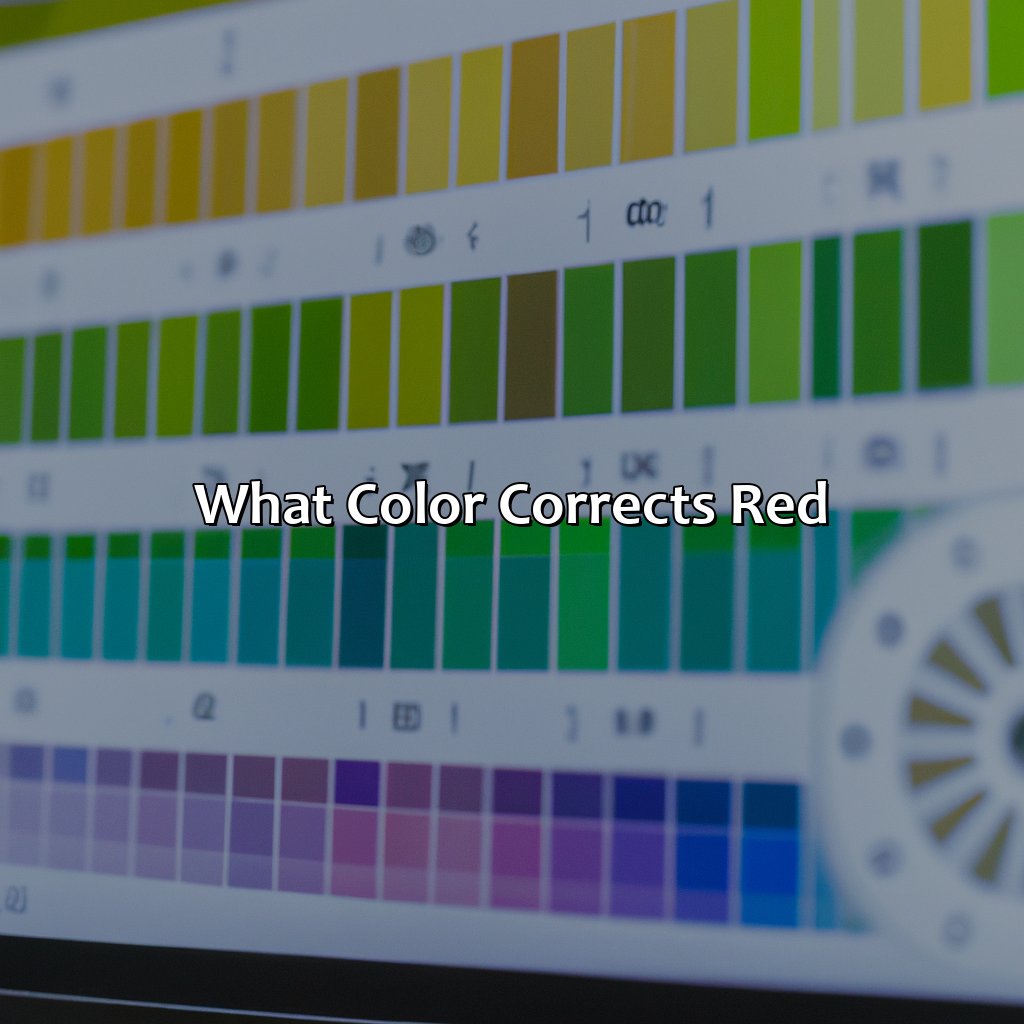Key Takeaways:
- The color brown symbolizes earthiness and naturalness: As a color that is often found in nature, brown represents the earth, soil, and natural materials such as wood and leather. It evokes feelings of warmth, comfort, and simplicity.
- Brown represents stability, reliability, and security: Because brown is associated with the earth and natural materials, it is often seen as a stable and reliable color. It gives a sense of security and grounding, and can be used to convey a sense of dependability.
- Brown has cultural and symbolic significance: In art and design, brown is often used to create a rustic or vintage feel. In fashion, brown is a versatile color that can be used to evoke a sense of elegance or a casual, earthy vibe. In symbolism and religion, brown is often associated with humility, simplicity, and the earth.
The Meaning of the Color Brown

Photo Credits: colorscombo.com by Dennis Lewis
To comprehend the symbolism of brown, investigate its psychology and natural associations. Let’s explore this hue, including its nuances and definitions. We’ll also consider its historical significance, revealing how it has been used in cultures throughout time.
Defining Brown
Brown is a rich, earthy color that is often associated with nature. It is created by mixing red, yellow, and black pigments in various proportions. Brown has been used as a color for clothing, architecture, and art since ancient times.
In contemporary culture, brown has acquired several different meanings. It can be seen as warm and inviting, symbolizing comfort and reliability. Brown can also represent stability and groundedness, suggesting simplicity and naturalness.
Moreover, brown is often used in cultural contexts to symbolize fortitude or steadfastness. In Native American traditions, for instance, it represents the importance of staying grounded and connected to the earth. Similarly, many spiritual practices use brown as a reminder of our connection to nature.
In addition to these symbolic meanings, brown has many different associations in nature. It is the color of soil, mud, dirt – all elements that are essential for life on earth to thrive. Trees have shades of brown in their bark and branches while wood—often used for construction—comes in various shades of brown too. Some animals like deer and bears have brown fur coats.
Therefore, it can be concluded that brown is a multifaceted color that carries several meanings across cultures and contexts. Whether representing simplicity or stability or evoking images of earthy beauty from nature—brown remains an ever-present color that we encounter every day all around us. Brown may be considered drab by some, but its historical significance cannot be denied.
Historical Significance
Brown’s Historical Importance:
Throughout history, the color brown has been used for various purposes. From cave paintings to ancient pottery, brown was a primary color in art. In Ancient Rome, brown was often used to symbolize humility and poverty while, in Medieval Europe, it became popular among nobility as a way of displaying wealth through expensive materials like leather and fur. Moreover, during the industrial revolution, brown became associated with coal mining and factory work due to its connection with earthy substances.
Another aspect of brown’s value historically is its use as a dye. The earliest brown dyes were created naturally from sources such as plants and insects but later they were synthesized chemically as well. Brown dye creation led to innovation in both the textile industry and medical world where it found use for staining tissues making internal features more visible for study.
Some lesser-known historical significance surrounding brown’s unique value include its usage in antique furniture primarily made with quality wood like mahogany or oak; another unique point is that some cultures believe that being covered in dirt enhances one’s immune system.
Pro Tip: While analyzing historical importance of any color make sure not to select events randomly; instead investigate how people interacted with colors emotionally or culturally during specific times in history.
Brown: the color that says ‘I may not be exciting, but I’m dependable and cozy.’
Psychological and Emotional Associations

Photo Credits: colorscombo.com by Ethan Green
For insights on the psychological and emotional implications of brown, check out this section. It has a focus on psychology and emotions. Learn how brown can create feelings of comfort, warmth, reliability, stability, groundedness, and simplicity. This section is separated into three categories:
- Comfort and Warmth
- Reliability and Stability
- Groundedness and Simplicity
Comfort and Warmth
When we perceive the color brown, it gives us a deep sense of comfort and warmth, evocative of being curled up on a comfy couch by a warm fire. Brown hues provide the instant feeling of relaxation and ease. This is why interiors with brown walls or furniture often feel very inviting. The color can also be used in branding to give off a homely vibe.
From a psychological perspective, our psyche associates brown with grounding and stability; therefore it makes us feel comfortable, secure and nurtured. We consider the color warm due to its connection to earth elements such as soil and wood that are linked with natural warmth.
Studies show that brown is one of the top colors when people were asked what color makes them feel most welcome in someone’s home.
Brown’s comforting properties speak for themselves when considering we all love our favorite pair of cozy woolen socks each winter season, usually coming in rich shades of caramel or autumnal hues.
Sources:
- Color Matters (“Why You Should Consider Brown for Your Home Interiors”)
- When life gets unstable, trust in brown – the color that’s always down to earth and reliable.
Reliability and Stability
Brown exudes qualities of reliability and stability, which instills a sense of trust in the mind of the observer. It signifies an unwavering and dependable presence, providing assurance to those around it.
The color brown is often associated with steadfastness and dependability, making it the perfect choice for corporate identities and branding. It conveys a sense of professionalism while being grounded and earthy.
Moreover, in the world of fashion, brown often reflects dependability and steadiness. It’s neutral color makes it an excellent choice to present safe, trustworthy personality traits. In product packaging or design work, brands use brown packaging to show that their products stand for something reliable and stable.
Additionally, utilizing brown in interior decor fosters feelings of calmness and security in a home or office environment. Using wood furniture pieces like chairs or tables gives off a feeling of consistency that inspires productivity.
Choosing brown paint for walls can also deliver serenity that promotes productivity when working at home or offices. Brown creates a comfortable environment that encourages concentration, focus, confidence while lowering anxious thoughts.
Therefore by incorporating brown into one’s brand from interior decoration to logo designing- evokes characteristics amongst people that are associated with reliability and stability while catering to other sensory comfort factors in various contexts as well.
Brown is like a plain white t-shirt, no frills or fuss, just grounded simplicity.
Groundedness and Simplicity
Groundedness and simplicity are key associations of the color brown. Brown tones bring an earthy, natural aesthetic that makes people feel grounded and connected to nature. This color is often used to convey a sense of minimalism, as it is simple yet timeless. Brown can also represent stability, safety and authenticity which are important traits for any product or brand.
When brown is combined with other colors in fashion, it can help to create an understated look that exudes style without being flashy. Brown is versatile enough to be paired with many different colors including white, black, blue, green, and even purple.
To fully appreciate the unique qualities of brown one must consider its relationship with context of nature. There’s something instinctively attractive about trees and their rich earth-like bark textures which appear comforting in modern landscape design and architectural applications. The rustic appeal of wooden elements such as decks, flooring and furniture gives texture to interiors that mimic nature’s authentic beauty.
To explore the potential depth of this color more thoroughly a Call-to-action can be added by simply encouraging readers to consider adding more brown photographs into their social media feeds or consider incorporating it into home design choices. Do not miss out on the great benefits brown has!
Brown may be the boring sibling of the color family, but in art, design, and fashion, it still manages to make a statement.
Cultural Representations

Photo Credits: colorscombo.com by Logan Wilson
To delve into the cultural implications of brown, explore art, design, fashion, symbolism, and religion. Unearth its many meanings in each. Here we’ll look at:
- Brown in art and design,
- Brown in fashion,
- Brown in symbolism and religion.
Brown in Art and Design
Artistic and design use of the color brown has a rich history. From Renaissance paintings to modern-day sculptures, brown has been used to evoke various themes, including warmth, earthiness, and simplicity. In art, brown can be applied as a primary shade or even just a subtle accent tone to create depth and dimension. Brown offers endless design possibilities for interiors and fashion products where it is associated with being timeless and classic. The color is often paired with other natural hues like green or beige to complement its organic feel.
The integration of brown in architecture and interior design is synonymous with elegance, luxury, and sophistication. Brown leather upholstery on furniture conveys comfort, while wooden furniture painted in brown evokes feelings of warmth and nature. It has become highly sought-after by designers because it creates an inviting atmosphere that resonates with consumers.
Brown’s influence on fashion dates back decades ago; the color’s relationship with creativity cannot be overstated in the industry. Earth-toned suits, chocolate dresses or shoes have been common fashion choices for years now. Designers prefer working with neutrals such as browns since they pair well with other pieces like blouses or shoes.
And so artists have drawn on metaphors around soil-brown skin colors as platforms for telling compelling narratives about people’s lives’ upheavals through their artistry; brown umbrellas thrown over brightly colored landscapes deliver messages of contemplation and consideration by the seashore horizontally. Browns represent many personalities’ facets throughout fine art.
Brown is the new black – it’s timeless, versatile, and surprisingly chic in the fashion world.
Brown in Fashion
Brown and its significance are prominent not only in nature but also in various aspects of human life, including fashion. Brown is a versatile color that pairs well with various hues and textures. It signifies earthiness, simplicity, and dependability. These qualities make brown an ideal choice for everyday wear.
In the fashion industry, brown has been popularized in various forms such as leather jackets, boots, belts, etc. which are always on-trend no matter what season it is. Brown adds warmth to an outfit and gives it an overall cozy feel that feels perfect for winter fashion.
Moreover, varying shades of brown have become a go-to staple for designers as they pair perfectly with bright or bold colors to create striking contrasts on the runway and off as well. Brown is often used in various forms of clothing like full monochrome brown outfits or small insignificant details like buttons or stitching to tie the whole look together.
In addition to this, fashion house runways worldwide have established chocolate brown as a sophisticated color suitable for formal wear too – often adding understated elegance to any attire making you stand out effortlessly.
Don’t miss out on incorporating this on-trend color into your wardrobe today; pair it with contrasting tones like black or white for an eye-catching yet simplistic look! Brown is the color of the earth, representing both our roots and our potential to grow – a concept that’s echoed in its symbolic significance across various religions.
Brown in Symbolism and Religion
Various cultures and religions have associated the color brown with deep symbolism for centuries. Brown represents humility, sacrifice, and piety in Christianity. In Hinduism, brown is a crucial part of shringar or decorating deities in temples, symbolizing love and compassion. The Buddha’s robe in Buddhism was initially intended to be sewn by patching together discarded pieces of cloth, resulting in a brown garment that represents frugality and simplicity. In Ancient Egypt, brown was linked with death and mourning. Overall, Brown has symbolic meanings related to life stages and observances such as funerals, harvest time, and holidays.
Nature’s favorite color, brown, is the perfect backdrop for autumn leaves, soil, wood, and animals, creating a sense of groundedness and simplicity.
Brown in Nature

Photo Credits: colorscombo.com by Albert Brown
To investigate brown in the natural world, we’ll dive deep into earth, trees, animals, and insects. To comprehend the importance of brown in nature, let’s explore three sub-sections. These are:
- Earth and soil
- Trees and wood
- Animals and insects
Earth and Soil
The natural aspects of brown are closely associated with the earth and soil. It represents the groundedness, stability, and simplicity of nature. Brown is a color that reflects the earthy and organic undertones present in soil.
Brown creates a connection to nature and reminds us of our roots. The color represents the foundation on which we stand, giving us stability and reassurance.
Various shades of brown are found in soil types across the world, ranging from rich deep brown to light sandy hues. Brown can be used to symbolize growth as soil is the provider for plants’ nourishment.
Soil’s sensory experience often relates to textures, which range from fine dust-like consistency to rough sandy beaches or gritty clays. Each variety adds unique properties to soils with different names like loam, clayey-loam, sandy-loam etc.
To incorporate this aspect into your life, consider surrounding yourself with natural elements associated with brown (earth/soil), such as wood furnishings or indoor plants. You could also take up gardening or outdoor activities that involve being close to nature’s earthy vibes.
Trees and wood – because nothing says ‘I love nature’ more than chopping it down for a coffee table.
Trees and Wood
The alluring color brown symbolizes the natural world, with trees and wood playing a key role. This shade is commonly associated with grounding and earthiness.
Trees are powerful representatives of nature, contributing to the aesthetic appearance and ecological balance of our planet. The color brown embodies all of these characteristics, representing organic matter in its purest form. Moreover, it is worth noting that brown timber has always been central to building construction and architecture due to its durability, flexibility and versatility.
Wood also holds historical significance in ancient cultures across the globe as a key material source for crafting tools, weapons, and sculptures. Similarly, many spiritual or religious ceremonies incorporate wooden objects such as instruments or symbols that represent faith.
A pro tip for choosing the right style? Wooden furniture with a glossy finish in light browns can blend perfectly with modern decor styles. Embrace this beautiful shade in your home’s interiors by bringing nature inside in various ways- be it through wood accents or trees planted indoors!
Why be afraid of spiders when you can just blend in with them in a brown outfit?
Animals and Insects
The color brown holds significant representation in the animal and insect world. Many creatures, such as owls, bears, and moose, have gorgeous shades of brown fur or feathers. Insects like beetles and bees often have brown wings or bodies. Brown is a neutral color that blends in with natural surroundings, helping animals and insects camouflage or hide from predators.
Not only is brown a protective shade for animals and insects, but it also represents stability and simplicity in their behavior. Animals like ants and beavers use brown elements to build their homes and ensure stability within their communities. Similarly, many wild animals have simple routines that bring them comfort in familiar settings.
Furthermore, brown can symbolize aggression in some animals, such as bulls or rhinoceroses, who use this color to intimidate rivals or defend themselves from danger.
Pro Tip: Next time you go on a nature walk or visit an insect exhibit at a museum, take notice of the different shades of brown around you. You may find hidden beauty in the neutral tones of our animal friends. Brown may not be the most exciting color, but it sure knows how to ground us in comfort and simplicity.
Summary of Key Points
In essence, Brown is a color that represents warmth, stability, and simplicity. Its significance has been passed down generations through cultural symbolism, nature and psychological associations. Here are the key points to note on the topic:
- Brown is seen as a comforting and grounded color that reminds people of earthly elements like soil, trees, and wood.
- In art and design, brown has been used to depict natural beauty or to evoke feelings of nostalgia or timelessness.
- In fashion, brown clothing can be used to create a classic and refined aesthetic while also being versatile across different styles.
- Across various cultures, brown has played an important role in religion through symbols that represent earth deities or divine wisdom.
- Ultimately, whether it’s the rich hues of a sunset or the humble simplicity of a wooden cabin, brown continues to hold an important place in our collective understanding of what it means to be human.
Pro Tip: Experiment with different shades of brown in your interior design choices to create a cozy and inviting space. Alternatively, pair light browns with bolder colors for a sophisticated look.
Final Thoughts on the Meaning of Brown
With a deeper understanding of the color brown, it is evident that its meaning extends far beyond a mere hue. Brown represents earthiness, reliability, simplicity, warmth and comfort. It has significant cultural and natural associations making it a complex color to interpret.
Brown adds warmth and intimacy to any space, reflecting a necessary sense of security, groundedness, and stability. Furthermore, this color embodies an essential human need to feel connected with nature and provides an emotional release from the fast pace of modern life.
In addition to its representation in fashion and art, brown has spiritual significance in Native American culture where brown shades are used in rituals for healing. The association with nature is also seen with brown representing the earth upon which all of life grows.
It’s worth noting that some ancient wall paintings dating around 30 BCE were found with early impressions of different colors made mainly by accident while using mud during prehistoric times. This suggests how integral the color brown always has been.
Some Facts About What Does the Color Brown Represent:
- ✅ Brown is often associated with earth and nature, representing stability and support. (Source: Color Matters)
- ✅ The color brown is often perceived as warm and inviting, evoking feelings of comfort and security. (Source: Sensational Color)
- ✅ In fashion, brown is considered a versatile and neutral color that pairs well with many other colors. (Source: The Trend Spotter)
- ✅ Brown is used in many logos and branding, representing reliability and dependability. (Source: 99designs)
- ✅ In psychology, brown is associated with practicality and groundedness, with some studies suggesting it can also induce feelings of sadness or isolation. (Source: Verywell Mind)
FAQs about What Does The Color Brown Represent
What does the color brown represent?
Brown is known to be a warm and neutral shade that is often associated with the earth, wood, and nature. It represents a sense of stability, warmth, and reliability. Additionally, it can also symbolize safety, comfort, and security.
Does brown have any cultural significance?
Yes, brown has both positive and negative cultural significance. In many cultures, brown represents spirituality, grounding, and humility. In some cultures, it is associated with poverty, decay, and despair. However, brown is often seen as a color of sophistication and elegance.
What emotions are associated with the color brown?
The color brown is often linked to feelings of warmth, stability, and security. It can also evoke a sense of seriousness, reliability, and comfort. Additionally, brown can represent sadness, loneliness, or depression as well.
How is brown used in interior design?
When used in interior design, brown can offer a rich and warm feel. It is often used in combination with other colors such as beige, cream, green, or blue. Brown can create a cozy ambiance in living spaces such as kitchens, living rooms, and bedrooms.
What are some notable idioms that include the color brown?
There are a few notable idioms that include the color brown such as ‘brownie points’ which means an imaginary credit for doing something good, ‘brown bag it’ which means to bring your lunch, and ‘brown out’ which means a decrease in electricity due to overload.
What are some popular objects that are brown in color?
Brown is a ubiquitous color in our daily lives; here are some popular objects that are brown in color: wood, soil, paper bags, coffee beans, leather jackets, teddy bears, chocolate, and peanut butter.






